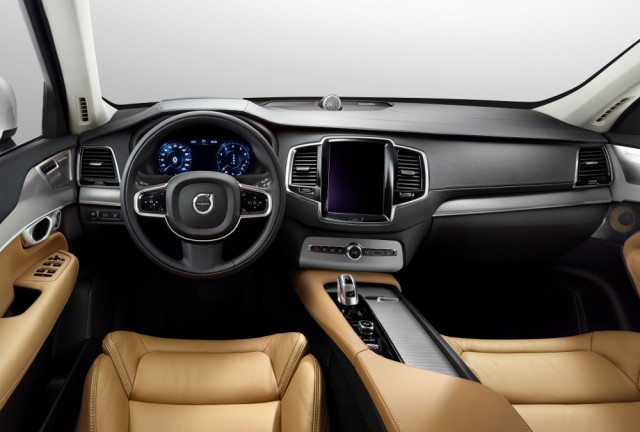by John Voelcker of www.thecarconnection.com
The 2016 Honda Pilot and the 2016 Volvo XC90 are both large,
seven-seat family utility vehicles, though they're about as far away
from traditional SUVs in refinement and design as you can get.
Both are new this year, and the two cars are among our highest-rated crossover SUVs. Which one is right for you?
Either vehicle will provide comfortable accommodation for up to seven
people, though the Pilot feels more spacious inside and has more
family-friendly touches. The Volvo is higher on the luxury scale,
despite an exterior design that's quiet and evolutionary for the
sensible Swedish brand. Either one is a good purchase, but the Honda
represents better value for money, and it wins on that basis.
The new and more rounded shape of the Pilot moves away from the
previous model's truck-like lines. The profile is elegant, with a nice
proportion of glass to metal, and the lower front end and horizontal
grille play nicely off each other.
While the exterior lines of the XC90 instantly say Volvo, it's
crisper and more fluid than its 15-year-old predecessor. Its shape also
effectively disguises the seven-seat vehicle’s size; the Volvo simply
doesn’t look as large as it is. Nor does it telegraph its prestige; as
one Volvo executive said, the XC90 is a car for people who “do not look
for a brand that defines them.”
Inside, the new Pilot is very well finished, combining elements from
the current Accord with a few touches from the CR-V. On some versions, a
huge panoramic roof opens up the cabin to a flood of natural light. The
front seats are just about ideally shaped, and with step-in height
about an inch lower than before, the Pilot is an even better bet for
smaller or older drivers.
The Honda's middle row is adult-friendly, and for the first time, you
can get a version with two captain’s chairs and a pass-through. The
seat reclines for long trips and has its own tray table and cup holders.
The push of a button folds down the second row, for access to the back
seat, which has enough space for two adults and a surprising amount of
head and leg room. Abundant cargo space includes cupholders everywhere,
and a console big enough for an iPad.
As for the XC90, its luxury is on full display in a widely-lauded
interior that distinguishes it from a host of German competitors. The
seats are superbly comfortable, and the interior shapes in stitched
leather, textured metal, and matte wood are layered to suggest
Scandinavian furniture. The 9-inch touchscreen display in the center of
the dash responds quickly to tablet-style commands, and is pleasantly
intuitive.
The Volvo's second-row seats slide forward and backward, and the
third row will accommodate two adults if they bargain for legroom with
second-row riders. Theater-style seating means each row is slightly
higher than the one in front, and outward vision is excellent —aided by
large windows and the huge panoramic sunroof that’s a standard feature.
The Honda Pilot is powered by a 280-horsepower V-6 paired to either a
six-speed automatic or a new nine-speed on Elite models. Front-wheel
drive is standard, all-wheel drive is an option, and there's no plusher
ride or more relaxed steering in this segment, with the Pilot feeling
mature and luxurious at the wheel. Fuel economy is as high as 23 mpg
combined.
The bulk of Volvo XC90s will come with a 316-hp turbocharged and
supercharged 2.0-liter four-cylinder engine mated to an eight-speed
automatic transmission. All-wheel drive is standard, and fuel economy is
rated at 22 mpg. On the road, the XC90 handles like a car, with good
steering feedback, predictable roadholding, and sprightly performance
despite its small engine. A plug-in hybrid variant can run on its
gasoline engine, on a 60-kilowatt (82-hp) electric motor on the rear
axle, or on both together when needed.
Both vehicles get excellent safety ratings and have already been
dubbed Top Safety Pick+ winners by the IIHS. The Honda Pilot gets the
top five-star overall rating from the NHTSA; the agency hasn't yet
tested the latest XC90. Both vehicles also have a full suite of
electronic active-safety systems.
The Pilot ranks higher--earning 8.8 points out of 10, against the
Volvo's 8.4--primarily for its better third-row space and much more
affordable price tag. The XC90 scores lower on safety, not because we
don't expect it to be at the top of the ratings, but because it hasn't
yet been tested by the NHTSA, whereas the Pilot has.
In the end, the Honda is less expensive, slightly more capacious, and
among the most flexible seven-seaters we've tested. But the Volvo is
more luxurious and has a nicer interior, as well as a plug-in hybrid
option. Which one you choose may come down to balancing cost, luxury,
and practicality--but either is a good choice in our view.
Source (with spec comparisons and more pictures);
http://www.thecarconnection.com/news/1102046_honda-pilot-vs-volvo-xc90-compare-cars































